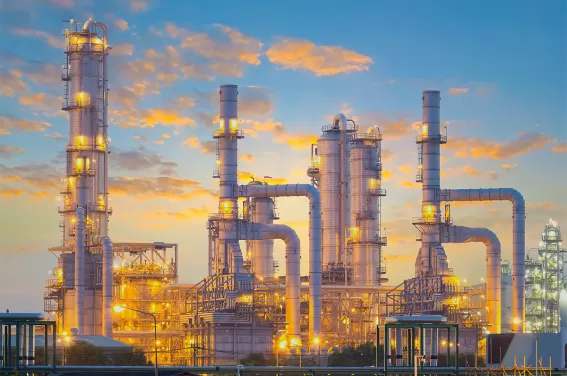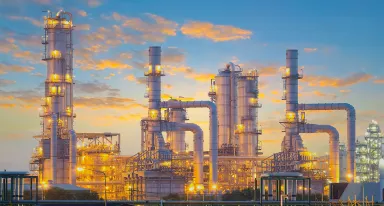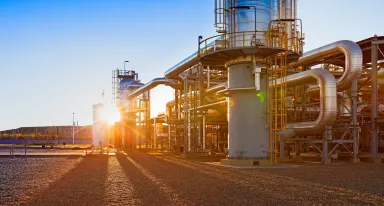
Complying with the Environment Act 2021 (Stack Emission Monitoring)

Are you seeking guidance on how to manage your industrial emissions?
Calibration mixtures for emission monitoring equipment
To demonstrate compliance, emissions producers (factories) need to use emission monitoring equipment. To get accurate and reliable results from this equipment, Air Liquide offers calibration mixtures — accredited where appropriate — as well as instrument and zero gases, gas handling equipment, accessories and services to help manage your gases and gas supply.
When in the EU the UK followed the Industrial Emissions Directives (2010 & 2015). Upon leaving the EU the UK has essentially maintained the regulations, with UK regulatory bodies replacing the EU equivalent within the UK legislation. The EU regulations were transposed into the Environment Act 2021.
Current legislation focuses on all polluting plants. Initially, this concentrated on regulating large combustion plants (LCPs) — those with a rated thermal capacity equal to or greater than 50 MW. This includes power stations, waste to energy installations, metals industry factories (steel, aluminum, and iron), refineries, petrochemical units, glass production, cement works, and paper mills. In more recent times the regulation has extended to smaller plants, so called medium combustion plants (MCPs) — those with a rated thermal capacity between 1 and 50 MW.
UK BAT Conclusions
Best available techniques (BAT) aim to prevent or reduce emissions and impacts on the environment.
Techniques include:
- the technology used
- how the installation is designed, built, maintained, operated and decommissioned
Industrial installations with specific types of activity must use BATs to prevent and reduce emissions to air, water and land.
The UK BAT system is the mechanism by which the techniques are established through an evidence led, collaborative approach.
BAT was adopted and applied across the European Union (EU) by the European Commission as BAT Conclusions under the Industrial Emissions Directive (IED) (Directive 2010/75/EU).
Existing EU BAT continue to have effect in the UK through the EU Withdrawal Act 2018. They are available in best available technique reference documents or BREFS.
However the UK no longer needs to meet the requirements of any new EU BAT - except for Northern Ireland (NI) where Article 4 of the NI Protocol sets out the sectors remaining under EU IED.
MCPs and livestock farms
“Not unexpectedly, the UK is gradually taking a stricter stance on air pollution emissions,” explains Simon James, Research & Analysis Offer Deployer at Air Liquide. “This means that MCPs will also need to measure their pollutants. New plants have been doing this since December 2018, while existing plants need to have registered before 1st January 2024. Meanwhile, the current legislation is under review with the UK BAT being the main route that plants must comply with. It’s meant to further reduce air emissions to meet the zero pollution ambition by 2050“.
EN 14181 emission monitoring
“The IED requires all emitters to fully measure their emissions. For this, they need suitable emission monitoring systems operated according to the EN 14181 quality assurance standard. And that’s where we come in. Air Liquide has an extensive portfolio of calibration gases and pure gases to get the best and most trustworthy results from these monitoring systems.”
“We obviously make sure that the gases conform to the required accuracy. This means that the uncertainty levels are well within EU specs. For quality assurance level 1 (QAL1) and 3 (QAL3) measurements, we offer non-accredited mixtures with a ± 2% analytical accuracy. For quality assurance level 2 (QAL2) and annual control measurements (AST), we offer ISO 17025-accredited mixtures.”
Joining forces with the national metrology institutes
Air Liquide works closely with the metrology institutes, including VSL in the Netherlands and NPL in the UK. “We have several ongoing research projects in close cooperation with these institutes. In most cases, this is about stability studies of different components. Through these research programmes, the quality and stability of the reference materials can be further perfected. This also allows us to guarantee the shelf-life mixtures, resulting in greater peace of mind for our customers.”
“Speaking of peace of mind, we believe that short and reliable lead times are key. We have a specialty gases plant in the UK in Stoke, supported by sister plants in Benelux, Germany and France, where we have a wide range of calibration mixtures and instrument gases available, offering reliable delivery times.”
Traceability: what it really means
“In this market, the term traceability is unfortunately often misused, which could have costly consequences. True traceability means that ISO 17025-accredited gases have to be traceable to reference standards issued by national metrology institutes.
There has to be an auditable chain of direct measurements linking the value of the calibration gas back to primary standard gas mixtures and ultimately to the SI units. If these conditions aren’t met, the traceability claim is unjustified.”
Air Liquide’s most popular measurement gases
“We’ve further expanded our range of ISO 17025-accredited calibration gases as well as our offer of non-accredited traceable mixtures. Our product range offers very low uncertainties, ±1%, with a wide concentration range and a comprehensive choice of components.”
Our ALPHAGAZ-1™ — 99.999% — nitrogen and air gases are mainly used for zero checks. Such a zero check is performed with a gas that does not contain the component to be analysed — hence the term zero. “In addition, we also offer ALPHAGAZ Mix™ calibration mixes, which are available in binary form — a pollutant and a balance gas — and in multi-component mixes. We also provide the necessary accessory equipment, such as pressure regulators, needle valves, point-of-use systems, gas distribution panels, pigtails, and hoses.”
“We now also supply nitrogen dioxide (NO2) in nitrogen, with an uncertainty of ±1% and a certified NOx value. For hydrogen chloride [HCl], ammonia [NH3]and hydrogen fluoride HF we offer guaranteed stability, which is quite an achievement given the nature of these complex mixtures.”
Services
- A 3 day lead time for pure gases and standard mixtures in stock
- Certificates of analysis are available on each cylinder and digitally
- Tools to alert customers to upcoming end of shelf-life gases giving early warning to re-order in time
- We offer safety training and gas hardware maintenance
Making things easier
Air Liquide’s extensive offering helps customers deal with stack emission monitoring requirements and achieve corporate social responsibility targets for reduced emissions, reduced carbon footprint and improved energy efficiency.
For Simon, the idea behind all this is that Air Liquide takes care of the gases and removes any pain points. “That means customers can focus on their core business.”
Need more information?
Contact Robert Farquharson
E: robert.farquharson@airliquide.com

